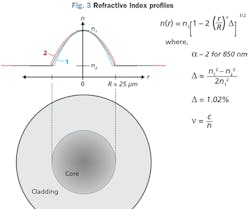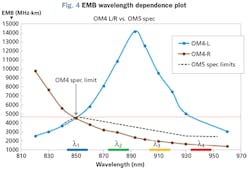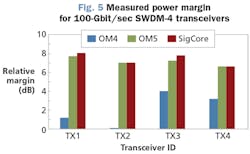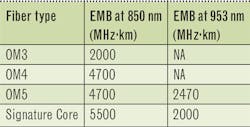Detailing the actual differences among laser-optimized multimode fiber types
By Dr. Rick Pimpinella, Panduit
Since the standardization of 10-Gbit/sec Ethernet (10GBase-SR) and laser-optimized OM3 multimode fiber (MMF) in 2002, the deployment of MMF has been rapidly growing and is now commonplace in most data communication networks. However, with the relentless demand for increases in Ethernet data rates and the need for longer reaches, new MMF types including OM4, OM4+, and OM5 have appeared on the scene, all touting higher performance. The questions we address in this article are, “What are the real differences between these fiber types?” and, “What is fact versus fiction?” Here we will discuss the fundamental properties of multimode fiber and explain the actual differences between today’s laser-optimized OM3, OM4, OM4+, and OM5 multimode fiber types to answer these questions.
Three representative optical modes: (a) a low-order mode where light travels in a direct path close to the optic axis of the fiber core; (b) a meridian mode where the light travels along a sinusoidal path through the optic axis; and (c) a skew mode where the light travels in a corkscrew path in a region defined by two caustic surfaces.
In general, the difference between MMF types is the minimum bandwidth, or more precisely, their minimum effective modal bandwidth (EMB), and their EMB wavelength dependence. The EMB metric will be explained in more detail, but at this time it suffices to say EMB is a measure of the MMF’s ability to minimize the distortion of the transmitted optical signal as it propagates through the fiber. The higher the EMB, the lower the optical signal distortion.
Due to process variations in the fiber manufacturing process, there is a relatively large distribution of MMF bandwidths. Following the fabrication process, based on the fiber’s measured EMB, the fibers are sorted as OM3 and OM4, where OM3 has an EMB of at least 2000 MHz·km and OM4 has an EMB of at least 4700 MHz·km at the measurement wavelength of 850 nm. Therefore, the only difference between OM3 and OM4 is the minimum guaranteed EMB. However, EMB alone is not sufficient to predict the performance of an optical channel. As we will discuss, the spectral pattern of the light emitted by an optical transmitter also plays a critical role in the total bandwidth of the MMF channel, which can be enhanced by OM4+ type fiber. To understand the overall bandwidth of an optical channel, we must first consider how light propagates through an optical multimode fiber.
A multimode fiber with a refractive index profile that resembles profile 1 in this illustration will exhibit modal-chromatic dispersion compensation. In such a fiber, higher order modes will travel faster, because the refractive index is lower. Lower-order modes will travel slower. Fibers with these characteristics have a peak EMB at a wavelength longer than 850 nm.
Fiber modes
Light is a self-sustaining propagating electromagnetic field exhibiting wave-like properties. Due to its wave nature, when an optical signal enters the core of the fiber, the light splits and travels through the fiber core along discrete optical paths called “modes,” where each of the traveling waves carry portions of the optical power and do not destructively interfere among themselves. The optical paths are called modes because the paths are mathematically described by the so-called wave equation, where the solutions to the wave equation are defined as modes.
Figure 1 illustrates the optical paths for three possible modes. For standard 50-micron core MMF, the fiber can support as many as 380 discrete modes for light having wavelengths in the 850-nm spectral region. Although the modes represent different optical pathways, many of them are indistinguishable in terms of their propagation properties and therefore can be grouped into 19 so-called mode-groups, where their relative propagation delays are used to calculate the fiber’s EMB. The objective in fabricating MMF is to vary, i.e. “grade,” the refractive index of the glass comprising the fiber core so that light traversing a direct path close to the optic axis experiences a high refractive index on average, which reduces the speed of the mode, and light traversing in a “high-order” mode (such as the skew mode shown in the figure) encounters a lower refractive index on average, thereby increasing the speed of the mode. In this way, no matter which path the light travels, the average velocities are equalized so that all optical modes—each carrying a portion of the signal power—arrive at the output end of the fiber at the same time. Any relative delay in the modes has the effect of increasing the width of the optical signal. This is called modal dispersion, and graded-index multimode fiber is designed to minimize modal dispersion, thereby increasing the bandwidth.
The EMB value is determined by first measuring the relative delays of the fiber mode groups, called differential mode delay (DMD). Next, weighting factors that represent laser emission patterns are applied to the DMD data, and finally mathematical computations are performed to calculate the minimum EMB. Hence, EMB is a calculated metric.
These images show the location of spectral wavelengths from an 850-nm VCSEL measured at the output of an OM4 fiber.
Laser modes
Multimode optical transceivers utilize lasers fabricated on wafer substrates called vertical cavity surface emitting lasers (VCSEL). During the development of 10-Gbit/sec Ethernet and OM3 fiber, it was assumed that VCSELs launch the same optical spectrum into all the different modes uniformly. However, in 2008 Panduit fiber researchers discovered that is not the case. Shorter wavelengths are emitted at large angles normal to the surface of the VCSEL and consequently, couple into higher-order fiber modes near the outer region of the fiber core. Conversely, longer VCSEL wavelengths are emitted at smaller angles and tend to couple into low-order modes close to the fiber-optic axis. Because different fiber modes contain different wavelengths, in addition to modal dispersion due to variations in refractive index, the modes undergo a chromatic dispersion due to their differences in wavelength relative to each other.
Depending on process variation in the manufacturing of the OM3 and OM4 fiber, when coupled to a VCSEL, the combination of modal and chromatic dispersions will either improve or degrade the fiber’s DMD and therefore, the EMB when operating as an optical communication system.
In Figure 2 we show measurement data illustrating how the different VCSEL wavelengths tend to propagate in the different fiber modes. We observe that the longest wavelength (850.452 nm) is confined to propagate in the inner modes, indicated by the yellow color, whereas the shorter wavelengths, for example 849.108 nm, propagates farther away from the core center. Due to the chromatic dispersion effect in glass, different wavelengths propagate at different speeds in the fiber, thereby altering the mode group delays, and consequently, the total combined fiber-VCSEL channel bandwidth. In other words, as a result of this spectral-spatial coupling of VCSEL modes into fiber modes, the performance of a multimode optical channel depends on both the fiber’s DMD and the VCSEL’s spectral output characteristics, which results in a modal and chromatic dispersion interaction.
It is possible to select OM3 and OM4 fibers with a specific DMD characteristic so that when used with a VCSEL, the resulting channel bandwidth is improved. This is accomplished by selecting fibers, where the refractive index profile, as a result of manufacturing process variation, is biased toward having a peak EMB at a longer wavelength than 850 nm. This subset of fibers is represented by a refractive index profile that resemble the profile labeled “1” in Figure 3. For a refractive index profile resembling “1,” higher order modes will travel faster (because the refractive index is lower), and conversely, lower-order modes will travel slower. When coupled to a VCSEL, due to the spectral bias of the output signal, the shorter wavelengths are launched into the higher-order fiber modes and will travel slower due to chromatic dispersion, thereby compensating for the lower refractive index. The result is an equalization of higher-order and lower-order mode group delays at the output of the fiber, yielding an increase in data communication channel performance. We call this effect modal-chromatic dispersion compensation. Panduit’s Signature Core OM4+ is the first fiber type that provides this enhancement. It is specified with a unique DMD requirement that will guarantee dispersion compensation providing the highest channel performance possible in multimode-VCSEL systems. Moreover, the fiber’s refractive index design also produces improved mode group delay equalization at longer wavelengths, making it a wideband MMF for short wavelength division multiplexing (SWDM) applications. Fibers that resemble the alpha profiles labeled “2” exacerbate the modal-chromatic dispersion interaction and therefore degrade channel performance at longer wavelengths.
The black dashed line indicates the specification for OM5 EMB wavelength dependence. The blue and brown lines are the measured EMB wavelength dependence for two minimally compliant OM4 fibers. These two fibers represent the extreme variations in peak EMB wavelength for OM4, which is specified only at 850 nm.
OM5 wideband multimode fiber
The development and success of our Signature Core fiber led to a growing interest to define a new fiber type with improved performance at longer wavelengths. A TIA-42.12 subcommittee was formed to specify a new fiber type that has a higher EMB at longer wavelengths. The maximum wavelength at 953nm was chosen to accommodate future SWDMapplications.
The new fiber type was initially called wideband MMF, and the TIA standards committee was chaired by a Panduit fiber research engineer. The International Electrotechnical Commission (IEC) adopted the TIA WBMMF specifications and named the new fiber OM5. Table 1 lists the types of laser-optimized MMF available today.
To understand the difference between OM4 and OM5, we refer to Figure 4. In Figure 4, we plot the EMB wavelength dependence for two minimally compliant OM4 fibers. Due to manufacturing process variation, all OM4 fibers will have peak EMBs at wavelengths below or above the nominal wavelength of 850 nm. These two fibers represent the extreme variations in peak EMB wavelength dependence. OM4 is only specified for 850 nm and therefore, the bandwidth at longer wavelengths, e.g. 953 nm is unknown.
The specification for OM5 EMB wavelength dependence is shown by the dashed line in Figure 4. For typical 850-nm transmission, OM4 and OM5 have identical EMB specifications of 4700 MHz·km. At 953 nm, OM5 has a specified minimum EMB of 2470 MHz·km, whereas the EMB of OM4 can vary from 1450 MHz·km to 2700 MHz·km.
Note that for transceivers operating at 850 nm as specified in IEEE 802.3 (Ethernet) and T11 Fibre Channel standards, OM5 is equivalent to OM4 (EMB of 4700 MHz·km) and provides no benefit. There is, however, one 400-Gbit/sec Ethernet (400GBase-SR4.2) and several non-standard SWDM transceivers that specify OM5 to a guaranteed advertised channel reach.
Although SWDM applications use duplex fiber cabling, the cost benefit relative to parallel optics is only realized when channel reaches exceed 100 meters, the maximum specified distance, at which point the lower structured cabling cost offsets the higher cost of the SWDM transceiver. It is also important to note that OM5 comes at a premium, and Ethernet and Fibre Channel transceivers using parallel optics enable switch-port breakout. SWDM does not support breakout, nor are they compatible with Ethernet or Fibre Channeltransceivers.
One final point regarding OM5 is its chromatic dispersion. During the development of the TIA 42.12 OM5 specification, it was brought to the attention of the subcommittee that the chromatic dispersion of OM3 and OM4 fibers is less than that specified in industry standards. A round-robin among six companies (including Panduit) was conducted to verify a lower chromatic dispersion for MMF can be specified. As a result, it was decided the chromatic dispersion spec for OM5 can be reduced. This, however, does not mean OM5 has lower chromatic dispersion than OM3 or OM4; only the specified value has been lowered.
This graph shows the relative margin of multimode fiber types OM4 (blue), OM5 (green) and OM4+ (red, labeled SigCore), based on bit-error-rate test results for 100-Gbit/sec SWDM-4 transmission over 100 meters of fiber. Margin refers to the optical attenuation that was added to the channel before the bit error rate exceeded industry standard limits.
Measured performance comparison
Channel performance is measured in terms of bit error rate (BER), where long strings of random data bits are launched into a channel under test, and then detected at the output of the channel by a test receiver. A comparator compares sequences of billions of random bits and counts those bits detected in error. Industry standards require no more than 1 error bit out of every trillion bits transmitted. In Figure 5, we show the BER test results for 100-Gbit/sec SWDM-4 transmission over 100 meters of the three high-bandwidth fiber types, OM4, OM4+ (labeled SigCore), and OM5. The results are plotted in terms of relative power margin, where higher margin equates to higher performance. The power margin is the optical attenuation that was added to the channel before the BER exceeds the industry standards limit. These high-speed channels are bandwidth-limited, and not attenuation-limited. Data was obtained for four 100G SWDM-4 transceivers, labeled TX1-TX4. The data shows OM5 and OM4+ (SigCore) have equivalent performance for SWDM-4 transmission, and they both provide the same reach and power margins ranging from 3 to 7 dB over standard OM4 fiber.
It has been advertised that OM5 has four times the bandwidth of OM4; this is a play with words. All laser-optimized MMF types can carry four-wavelength transmission and therefore, can be characterized as having four times the bandwidth of only one wavelength. The only difference between these fibers is the maximum channel reach over which the four wavelengths can be transmitted. OM5 provides greater reach than OM3 and OM4, and equivalent to SigCore OM4+.
So, what is fact and what is fiction? The longer reaches specified for SWDM-4 transceivers are not due to a lower chromatic dispersion or higher bandwidth for OM5, but instead due to the fact that the transceivers are optimized to meet these extended reaches. It is, however, fair to say OM5 is better than OM4 for SWDM-4 applications because the EMB at 953 nm is specified for OM5. For all but the one SWDM Ethernet transceiver (IEEE 802.3cm 400GBase-SR4.2), OM4 and OM5 are equivalent.
Our Signature Core brand OM4+ is selected from the OM4 production population based on a uniquely specified DMD requirement that enables the compensation of chromatic and modal dispersions, thereby reducing the total dispersion and significantly increasing the EMB of the channel. Dispersion-compensating OM4+ improves overall channel performance and extends channel reach by about 25 percent. Channel performance testing at a U.S. Air Force base using 100-Gbit/sec SWDM-4 transceivers showed that OM4+ outperformed OM5, achieving a 100-Gbit/sec channel reach of 505 meters versus 467 meters for OM5 using betatransceivers.
In conclusion, the selection of a MMF type should be based on future projected high-speed data rates, maximum required channel reach, and needless to say, cost.u
Dr. Rick Pimpinella is a Panduit Fellow, Optical Fiber Research. He received B.S., M.S., and Ph.D. degrees in Physics from New York University Tandon School of Engineering. He joined Panduit in 2002, where he has managed the fiber business unit and fiber research department.





